Introduction
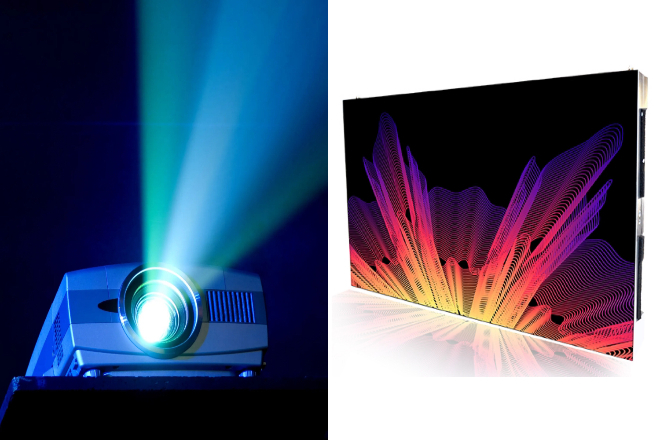
In today’s era of pursuing high efficiency and energy saving, the choice of display devices has become particularly important.
As common display technologies, LED displays and projectors are often used in various scenarios.
But have you ever wondered why LED displays are more energy-efficient than projectors?
How big is the difference between them in energy consumption, service life, and cost? This article will reveal the answers to these questions for you.
Table of Contents
Reason 1: The essential difference between LED and projector
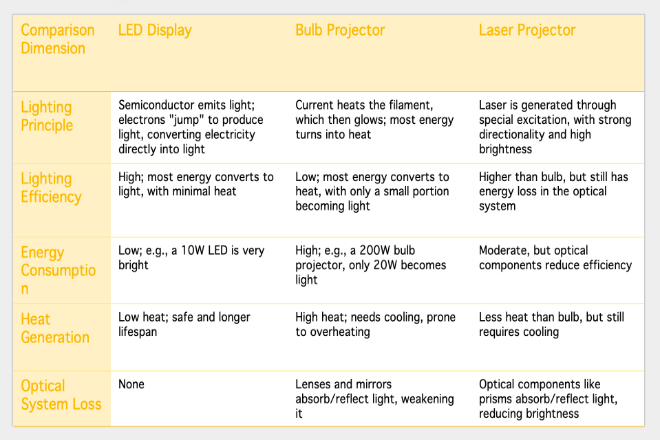
1). LED display
LED display is like a bunch of small light bulbs that can emit light, but these small light bulbs are made of a special semiconductor material.
When you power it, the electrons in these materials will “jump around” and then emit light.
This process is a bit like turning electrical energy directly into light, which is very efficient. Most of the electrical energy is turned into light, and only a small part of it is turned into heat.
Its advantages are:
1.1). Brighten quickly and save electricity:
Because most of the electrical energy is turned into light, the LED display is very bright and uses very little electricity.
For example, an LED bulb can emit very bright light with 10 watts of electricity, while an ordinary bulb may need 60 watts to achieve similar brightness.
1.2). Not very hot:
Because of the high energy conversion efficiency, the temperature of the LED display screen will not be very high when it is working, unlike traditional bulbs that will burn your hands. This is not only safe but also can extend the service life.
2). Projector
The way the projector emits light is much more complicated. There are two main types: bulb type and laser type.
2.1). Bulb projector
The light source of the bulb projector is an ordinary bulb, and the principle is similar to the incandescent lamp at home.
It heats the filament through the current, and then the filament will emit light.
This light-emitting method is very inefficient, most of the electrical energy is converted into heat, and only a small part is converted into light.
But there will be energy loss:
- Heat loss:
The bulb projector will be very hot when working because most of the electrical energy is converted into heat energy.
For example, a 200-watt projector bulb may only have 20 watts of electrical energy converted into light, and the remaining 180 watts are converted into heat.
This requires additional heat dissipation devices to cool down, otherwise the projector will easily overheat.
- Optical system loss:
There are many optical components in the projector, such as lenses and mirrors, which are used to focus the light emitted by the light source and project it onto the screen.
But these components will lose the energy of the light. For example, the lens will reflect part of the light, and the mirror will absorb part of the light, causing the light finally projected onto the screen to become very weak.
2.2). Laser projector
The laser projector uses a laser, which is a very special light with strong directionality and high brightness.
The laser is generated by a special excitation method. Although the luminous efficiency of the laser itself is higher than that of the light bulb, there will still be a lot of energy loss in the entire projector system.
Energy loss that will occur:
- Optical component loss:
The laser will also be lost when passing through the optical component. For example, when the laser passes through the beam splitter, part of the light will be reflected or absorbed, resulting in a decrease in light intensity.
Moreover, when the laser propagates in the air, it will also be scattered by particles such as dust in the air, further reducing the intensity of the light.
- Heat dissipation problem:
Lasers also generate heat when working, although not as much as light bulbs, but they still need to be cooled. These heat dissipation measures themselves also consume some energy.
In short, an LED display is like an efficient light-emitting expert. Most of the electrical energy can be converted into light, and it does not generate much heat, which is very energy-saving and safe.
However, the light-emitting process of projectors (whether bulb-type or laser-type) is complicated, and energy loss is high.
Most of the electrical energy is converted into heat. The intensity of the light projected on the screen is limited, and additional heat dissipation devices are required.
If it is for long-term use and has requirements for brightness and energy consumption, LED display is usually a better choice.
Reason 2: Accurate control of brightness and optimization of energy consumption
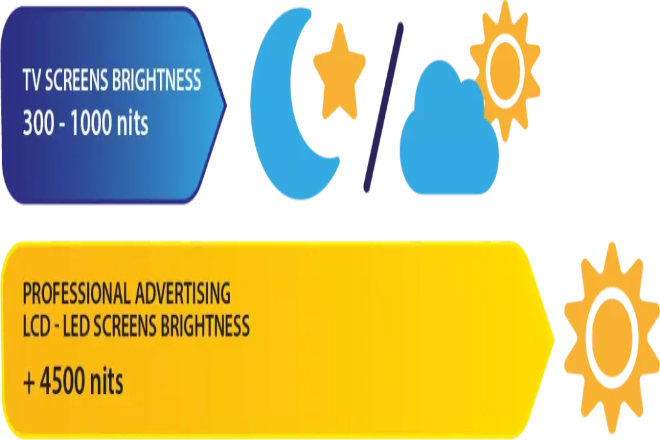
1). Intelligent brightness adjustment of LED display
The LED display is very smart. It can automatically adjust the brightness according to the surrounding light.
For example, when the ambient light is bright, the screen will automatically brighten so that you can see clearly.
When the ambient light is dark, the screen will automatically dim, which is not dazzling and can save electricity.
In addition, the brightness and energy consumption of LED displays are directly related.
When the brightness is lowered, the energy consumption will be significantly reduced.
For example, if the brightness is adjusted to half, the power consumption will be reduced by about half, which is both energy-saving and keeps the picture clear.
2). Fixed brightness requirements of projectors
Projectors are different. It requires very high brightness to make the picture clear, especially when there is strong light around.
For example, in a meeting room during the day, the projector must adjust the brightness to a very high level to prevent the picture from being “drowned” by the sunlight outside the window.
The brightness adjustment range of the projector is very narrow, and the brightness cannot be adjusted too low, even in a dark room.
Because the brightness is too low, the picture will be blurred. This leads to high energy consumption of the projector regardless of the environment.
For example, a projector may use 100 watts or even more power even in a dark room, while an LED display may only need about 10 watts in the same environment.
Finally, if you use it in a place with large changes in light, such as during the day and at night, an LED display is more suitable because it can automatically adjust the brightness, which is both power-saving and convenient.
Projectors are more suitable for use in environments with fixed light, such as special conference rooms or cinemas, and it is best to block the light. Otherwise, the picture will be affected.
Reason 3: Comparison of long-term energy consumption costs
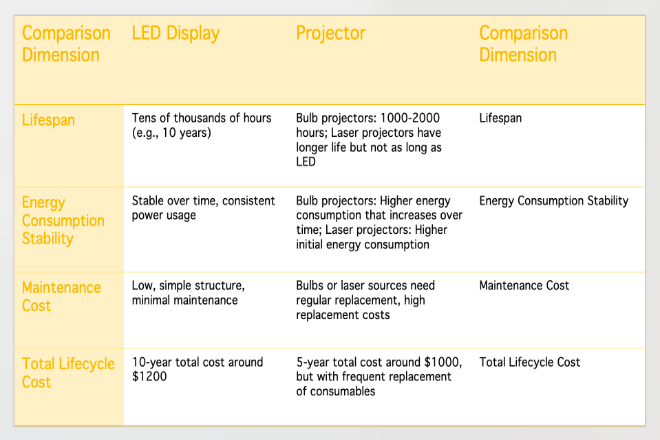
1). The long-life advantage of LED display screens
The service life of LED display screens is very long, generally up to tens of thousands of hours.
This is because its light-emitting principle is based on semiconductor materials, which are very stable and not easy to damage. Just like a sturdy and durable small light bulb, it will not break easily after many years of use.
1.1). Stable energy consumption
In the long-term use of LED display screens, the energy consumption has been relatively stable.
It is not like some equipment that consumes more and more electricity after being used for a long time.
The power consumption of LED display screens remains basically unchanged from the beginning to the end.
For example, an LED display screen is used for 10 years, and the annual electricity bill is almost the same.
1.2). Low maintenance cost
The maintenance cost of LED display screens is very low. Because it has a simple structure and is not easy to break, it does not need to be repaired frequently.
Even if there are occasional minor problems, it is easy to fix and will not cost too much money. This low maintenance cost can save a lot of money in long-term use.
1.3). Energy consumption cost of the whole life cycle
If the electricity and maintenance costs during the entire service life are taken into account, the cost of LED display screens is very low.
Assuming that an LED display screen is used for 10 years, the annual electricity cost is 1,000 yuan, which is 10,000 yuan in 10 years. Adding occasional maintenance costs, the total cost may be around 12,000 yuan.
2). Replacement of consumables and additional energy consumption of projectors
The service life of projectors is much shorter, especially its bulbs or laser sources. These parts will break down after a short time and need to be replaced regularly.
2.1). High cost of consumables
The bulbs or laser sources of projectors will wear out after a period of use.
For example, the bulbs of bulb-type projectors may need to be replaced after 1,000 to 2,000 hours. The life of laser sources will be longer, but it is not as good as LED display screens.
Each time a bulb or laser source is replaced, it costs hundreds or even thousands of yuan.
2.2). Additional energy consumption during replacement
After each replacement of the bulb or laser source, the projector needs to be re-debugged, which consumes a lot of electricity.
Moreover, the newly replaced bulb or laser source will have higher energy consumption in the initial stage because it needs to be “run-in.”
For example, the power of a new bulb maybe 20% – 30% higher than that in normal use in the first few hundred hours of use.
2.3). Energy consumption cost of the whole life cycle
If the electricity cost, consumable replacement cost, and extra energy consumption during the debugging process are taken into account during the entire service life, the cost of the projector will be much higher than that of the LED display.
Assuming that a projector is used for 5 years, the annual electricity cost is 1,500 yuan, which is 7,500 yuan in 5 years.
In addition, the bulb needs to be replaced every 2 years, 500 yuan each time, and 3 times in 5 years, which is 1,500 yuan.
Add the extra energy consumption during the debugging process, and the total cost may be around 10,000 yuan.
If you plan to use it for a long time, the LED display is definitely a more cost-effective choice.
It not only has a long service life and stable energy consumption, but also has low maintenance costs, which can save a lot of money in the long run.
Although the projector may look cheap at first, it will cost you more money to replace the bulb and extra energy consumption in the long run.
Reason 4: Difference in energy-saving potential between the two
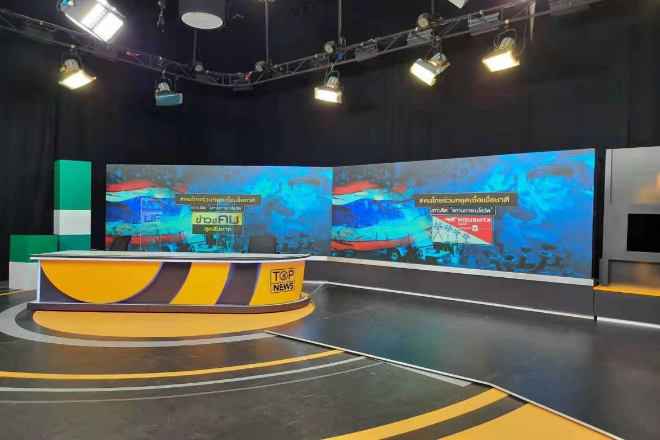
1). Upgrade of energy-saving technology of LED display screen
The energy-saving technology of LED display screens has been improving, which is mainly reflected in the following aspects:
1.1). High-efficiency chip
The chips used in LED display screens are getting more and more powerful. These high-efficiency chips are like super energy-saving small engines that can convert electrical energy into light energy more efficiently.
For example, the new chip can emit more light per watt of electrical energy, which is much more energy-saving than the old chip.
1.2). Intelligent drive circuit
The drive circuit of the LED display screen has also become very smart. It can accurately control the brightness and energy consumption of each LED lamp bead according to actual needs.
For example, there are bright and dark parts on the screen. The intelligent drive circuit can make the bright part use more electricity and the dark part use less electricity so that no electricity is wasted.
1.3). Heat dissipation management
The heat dissipation technology of LED display screens has also been continuously improved.
Although LED itself does not generate much heat, the heat dissipation system can better manage the heat and keep the display stable when working for a long time.
A good heat dissipation system can not only extend the service life but also further reduce energy consumption because less heat means less energy consumption.
1.4). Precise energy consumption control
The combination of these technologies enables LED displays to control energy consumption precisely.
For example, through intelligent driving circuits and high-efficiency chips, LED displays can dynamically adjust energy consumption according to the content of the picture.
If the picture is relatively simple, the energy consumption will be reduced; if the picture is very complex, the energy consumption will not soar.
This precise control makes the overall energy efficiency of LED displays higher and higher.
2). Energy-saving bottleneck of projectors
Projectors have also made some progress in energy saving, but they still face many challenges overall.
2.1). Heat loss bottleneck of lamp projectors
The energy-saving bottleneck of lamp projectors is mainly heat loss. When the lamp emits light, it generates a lot of heat.
This heat not only wastes electricity but also increases the internal temperature of the projector, requiring more heat dissipation measures.
For example, a 200-watt lamp projector may only have 20 watts of electricity converted into light, and the remaining 180 watts are converted into heat.
This heat loss is difficult to break through because the light-emitting principle of the lamp determines that it will inevitably generate heat.
2.2). Limitations of laser projectors
Although laser projectors are more energy-efficient than bulb projectors, they are still not as efficient as LED displays.
Although the light source of laser projectors is bright, a lot of energy is lost in the optical system.
For example, lasers are reflected or absorbed when passing through optical components, resulting in a decrease in light intensity, which requires higher power to compensate.
Moreover, laser projectors also require a lot of heat dissipation, and these heat dissipation measures themselves consume a lot of electricity.
2.3). Challenges of optical system optimization
Whether it is a bulb or laser projector, there are great challenges in optimizing the optical system.
The projector needs to focus light onto the screen through components such as lenses and reflectors, but these components always lose some light.
For example, the transmittance of the lens cannot reach 100%, and the reflector will also absorb some light.
These losses are difficult to avoid completely, resulting in limited energy-saving potential of the projector.
3). Comparison of the gap between the two in energy-saving technology
3.1). LED display:
Through high-efficiency chips, intelligent drive circuits and heat management technology, LED displays can accurately control energy consumption and continuously improve overall energy efficiency.
Its energy-saving technology has made significant progress and energy consumption has continued to decrease.
3.2). Projector:
- Bulb projector:
The heat loss bottleneck is difficult to break through, most of the electric energy is converted into heat, and the energy saving potential is limited.
- Laser projector:
Although it is worse than the bulb projector, the energy loss in the optical system is still large, and the overall energy efficiency is not as good as the LED display.
LED display has made rapid progress in energy-saving technology. Through high-efficiency chips, intelligent drive circuits and heat dissipation management.
It can achieve precise energy consumption control and continuously improve overall energy efficiency.
However, projectors (whether bulb-type or laser-type) face many bottlenecks in energy saving, such as heat loss and energy loss in the optical system, and the energy-saving potential is relatively limited.
If you want the device to be more energy-efficient, an LED display is undoubtedly a better choice.
Reason 5: Energy consumption performance of the two in different scenarios

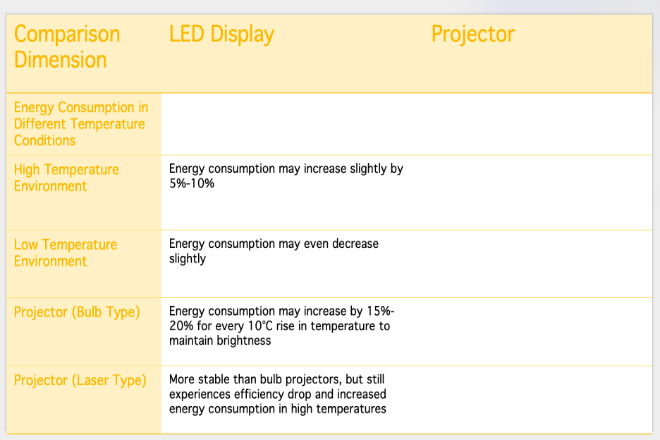
1). Energy consumption comparison under different ambient light
1.1). LED display
The LED display is very smart. It will automatically adjust the brightness according to the surrounding light. For example:
- Strong light environment:
In places with strong sunlight outdoors, the LED display will automatically brighten, but it will not waste too much electricity.
Because it is energy-saving in itself, even if it is brightened, the power consumption will not increase too much.
- Low light environment:
In a very dark room, the LED display will automatically dim, which is not glaring and can save electricity.
- Natural light environment:
In an ordinary indoor light environment, the LED display will also adjust the brightness according to the light to keep it clear and energy-saving.
1.2). Projector
The projector is not so smart. Its performance varies greatly in different light environments:
- Strong light environment:
If you use a projector in a place with strong sunlight, such as a conference room without curtains during the day, the projector must adjust the brightness to the highest level in order for everyone to see the picture clearly.
In this way, the power consumption will increase significantly, and it may use several times more electricity than usual.
- Low light environment:
In a very dark room, the energy consumption of the projector will be lower, but it is still higher than that of the LED display.
Because the light source efficiency of the projector is relatively low, even in a low light environment, a certain amount of power is required to maintain brightness.
- Natural light environment:
In an ordinary indoor light environment, the energy consumption of the projector is between strong light and weak light.
Although the interference of ambient light is not as serious as that of a strong light environment, the projector still needs a higher brightness to ensure the picture quality.
1.3). Experimental data and actual cases
Experiments have shown that in strong light environment, the energy consumption of LED display is only 30% – 50% of that of projector.
For example, in a company conference room, using LED display can save half of the monthly electricity bill compared with using projector.
In weak light environment, the energy consumption of LED display is also much lower than that of projector.
For example, in a small conference room, the monthly electricity bill of using LED display may be only 50 yuan, while the projector may cost more than 100 yuan.
2). The impact of temperature on energy consumption
2.1). LED display
The LED display is very “tough”; whether it is hot or cold, its energy consumption is relatively stable. For example:
- High temperature environment:
When it is very hot in summer, the energy consumption of LED display may only increase a little, such as 5% – 10%.
- Low temperature environment:
When it is very cold in winter, the energy consumption of LED display may even decrease a little.
2.2). Projector
Projectors are not so stable, and temperature has a great impact on their energy consumption:
- Bulb projector:
In high temperature environments, the luminous efficiency of the bulb will decrease, and the projector will increase power to maintain brightness.
For example, for every 10°C increase in temperature, the energy consumption of a bulb projector may increase by 15% – 20%.
- Laser projector:
Although laser projectors are better than bulb projectors, the efficiency of laser sources will also decrease in high-temperature environments, resulting in increased energy consumption.
2.3). Comparison summary
- LED display:
It can maintain low energy consumption under various ambient light conditions, and its energy consumption is very stable whether it is hot or cold.
- Projector:
Higher power is required to ensure visibility in strong light environments, and the energy consumption is very high.
In high-temperature environments, the energy consumption of bulb projectors fluctuates significantly. Although laser projectors are better, they are still not as good as LED displays.
If you want to save power in different light environments and don’t want the device to be too affected by temperature, LED displays are definitely a better choice.
Projectors consume too much power in strong light environments, and they tend to “get mad” when the temperature is high, and the energy consumption fluctuates greatly.
6. Conclusion
Through the above analysis, we can clearly see that LED displays have significant advantages in terms of energy saving, service life, and long-term costs.
Whether in strong light or weak light environments, LED displays can maintain high efficiency and energy saving, while projectors face many energy consumption bottlenecks.
If you are looking for a long-term stable, energy-saving, and efficient display device, LED displays are undoubtedly a wiser choice.
Finally, if you want to know more about LED displays, please get in touch with us.
